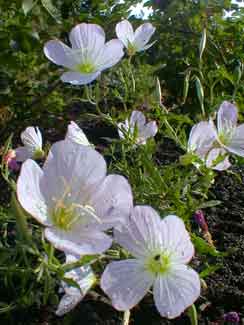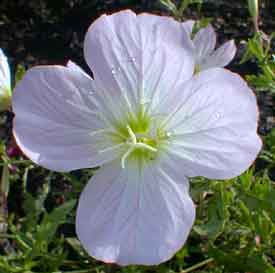
Mexican Evening Primrose; aka:
Showy Evening Primrose;
Showy Sundrops; or,
Pink Evening Primrose
"He rose, he ran, he stoop'd, he clutch'd;
And soon the Flowers, that Love let fall,
In Greed's hot grasp were fray'd and smutch'd."
-William Brighty Rands
(1823‚1880)
(1823‚1880)
Oenothera speciosa var berlandieri is commonly called Mexican Evening Primrose, though it is neither a primrose nor a night-bloomer. The cultivar 'Siskayou Pink' has large papery flowers of 'Siskayou Pink' are a clear pale pink, though there is considerable color variation in the species overall,from nearly white to darker pink.
It blooms best in full sun, & is highly drought tolerant despite its delicate appearance. It is in continuous flower late spring & all summer long. After it is finished blooming late in summer, the foliage dies back unattractively, but can be trimmed clear to the ground if its appearance is bothersome. It leaps back to life come spring.
 In a harsh xeriscape garden it can be an exquisite fill-in amidst larger plants, because it can really hold its own, although it could well overrun smaller perennials; ours grows amidst rugosa roses & woody subshrubs, so is not apt to displace anything as it spreads. It is only about six inches to a foot tall, but a clump can spread rhizomitously to cover increasing ground. It will regenerate from any fragment of its rhizome, so once it has colonized an area, it's for keeps.
In a harsh xeriscape garden it can be an exquisite fill-in amidst larger plants, because it can really hold its own, although it could well overrun smaller perennials; ours grows amidst rugosa roses & woody subshrubs, so is not apt to displace anything as it spreads. It is only about six inches to a foot tall, but a clump can spread rhizomitously to cover increasing ground. It will regenerate from any fragment of its rhizome, so once it has colonized an area, it's for keeps.In warm zones it has a high potential for being invasive. In zones with chilly winters it should die back sufficiently each winter to not be a burden. It's surprisingly cold-hardy as well as heat-hardy, & its main enemy is poorly draining soil in winter. At the height of summer it can do with occasional watering to remain lively.
The species is native to the American southwest & Mexico. The species variant name is after Jean Louis Berlandier (1805?-1851), a Belgian naturalist who came to Mexico in 1826 & made botanical & zoological collections & ethnographic studies in Texas as well as Mexico for many years.
During the Mexican Wars, he served as a physician, pharmacist, & interpreter at Matamoros near which, in 1851, he drowned in the San Fernando River. He was survived by a common-law wife who was Mexican, & their several children. Many of his papers, correspondences, & journey diaries are divied up between the Yale University library's special collections, Harvard's Gray Herbarium Library, & Smithsonian Institute Archiveds.